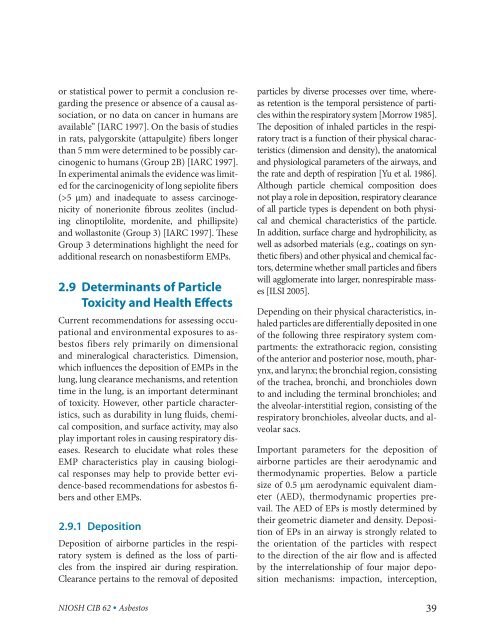Asbestos Fibers and Other Elongate Mineral Particles: State of the ...
Asbestos Fibers and Other Elongate Mineral Particles: State of the ...
Asbestos Fibers and Other Elongate Mineral Particles: State of the ...
- No tags were found...
You also want an ePaper? Increase the reach of your titles
YUMPU automatically turns print PDFs into web optimized ePapers that Google loves.
or statistical power to permit a conclusion regarding<br />
<strong>the</strong> presence or absence <strong>of</strong> a causal association,<br />
or no data on cancer in humans are<br />
available” [IARC 1997]. On <strong>the</strong> basis <strong>of</strong> studies<br />
in rats, palygorskite (attapulgite) fibers longer<br />
than 5 mm were determined to be possibly carcinogenic<br />
to humans (Group 2B) [IARC 1997].<br />
In experimental animals <strong>the</strong> evidence was limited<br />
for <strong>the</strong> carcinogenicity <strong>of</strong> long sepiolite fibers<br />
(>5 µm) <strong>and</strong> inadequate to assess carcinogenicity<br />
<strong>of</strong> nonerionite fibrous zeolites (including<br />
clinoptilolite, mordenite, <strong>and</strong> phillipsite)<br />
<strong>and</strong> wollastonite (Group 3) [IARC 1997]. These<br />
Group 3 determinations highlight <strong>the</strong> need for<br />
additional research on nonasbestiform EMPs.<br />
2.9 Determinants <strong>of</strong> Particle<br />
Toxicity <strong>and</strong> Health Effects<br />
Current recommendations for assessing occupational<br />
<strong>and</strong> environmental exposures to asbestos<br />
fibers rely primarily on dimensional<br />
<strong>and</strong> mineralogical characteristics. Dimension,<br />
which influences <strong>the</strong> deposition <strong>of</strong> EMPs in <strong>the</strong><br />
lung, lung clearance mechanisms, <strong>and</strong> retention<br />
time in <strong>the</strong> lung, is an important determinant<br />
<strong>of</strong> toxicity. However, o<strong>the</strong>r particle characteristics,<br />
such as durability in lung fluids, chemical<br />
composition, <strong>and</strong> surface activity, may also<br />
play important roles in causing respiratory diseases.<br />
Research to elucidate what roles <strong>the</strong>se<br />
EMP characteristics play in causing biological<br />
responses may help to provide better evidence-based<br />
recommendations for asbestos fibers<br />
<strong>and</strong> o<strong>the</strong>r EMPs.<br />
2.9.1 Deposition<br />
Deposition <strong>of</strong> airborne particles in <strong>the</strong> respiratory<br />
system is defined as <strong>the</strong> loss <strong>of</strong> particles<br />
from <strong>the</strong> inspired air during respiration.<br />
Clearance pertains to <strong>the</strong> removal <strong>of</strong> deposited<br />
NIOSH CIB 62 • <strong>Asbestos</strong><br />
particles by diverse processes over time, whereas<br />
retention is <strong>the</strong> temporal persistence <strong>of</strong> particles<br />
within <strong>the</strong> respiratory system [Morrow 1985].<br />
The deposition <strong>of</strong> inhaled particles in <strong>the</strong> respiratory<br />
tract is a function <strong>of</strong> <strong>the</strong>ir physical characteristics<br />
(dimension <strong>and</strong> density), <strong>the</strong> anatomical<br />
<strong>and</strong> physiological parameters <strong>of</strong> <strong>the</strong> airways, <strong>and</strong><br />
<strong>the</strong> rate <strong>and</strong> depth <strong>of</strong> respiration [Yu et al. 1986].<br />
Although particle chemical composition does<br />
not play a role in deposition, respiratory clearance<br />
<strong>of</strong> all particle types is dependent on both physical<br />
<strong>and</strong> chemical characteristics <strong>of</strong> <strong>the</strong> particle.<br />
In addition, surface charge <strong>and</strong> hydrophilicity, as<br />
well as adsorbed materials (e.g., coatings on syn<strong>the</strong>tic<br />
fibers) <strong>and</strong> o<strong>the</strong>r physical <strong>and</strong> chemical factors,<br />
determine whe<strong>the</strong>r small particles <strong>and</strong> fibers<br />
will agglomerate into larger, nonrespirable masses<br />
[ILSI 2005].<br />
Depending on <strong>the</strong>ir physical characteristics, inhaled<br />
particles are differentially deposited in one<br />
<strong>of</strong> <strong>the</strong> following three respiratory system compartments:<br />
<strong>the</strong> extrathoracic region, consisting<br />
<strong>of</strong> <strong>the</strong> anterior <strong>and</strong> posterior nose, mouth, pharynx,<br />
<strong>and</strong> larynx; <strong>the</strong> bronchial region, consisting<br />
<strong>of</strong> <strong>the</strong> trachea, bronchi, <strong>and</strong> bronchioles down<br />
to <strong>and</strong> including <strong>the</strong> terminal bronchioles; <strong>and</strong><br />
<strong>the</strong> alveolar-interstitial region, consisting <strong>of</strong> <strong>the</strong><br />
respiratory bronchioles, alveolar ducts, <strong>and</strong> alveolar<br />
sacs.<br />
Important parameters for <strong>the</strong> deposition <strong>of</strong><br />
airborne particles are <strong>the</strong>ir aerodynamic <strong>and</strong><br />
<strong>the</strong>rmodynamic properties. Below a particle<br />
size <strong>of</strong> 0.5 µm aerodynamic equivalent diameter<br />
(AED), <strong>the</strong>rmodynamic properties prevail.<br />
The AED <strong>of</strong> EPs is mostly determined by<br />
<strong>the</strong>ir geometric diameter <strong>and</strong> density. Deposition<br />
<strong>of</strong> EPs in an airway is strongly related to<br />
<strong>the</strong> orientation <strong>of</strong> <strong>the</strong> particles with respect<br />
to <strong>the</strong> direction <strong>of</strong> <strong>the</strong> air flow <strong>and</strong> is affected<br />
by <strong>the</strong> interrelationship <strong>of</strong> four major deposition<br />
mechanisms: impaction, interception,<br />
39

















